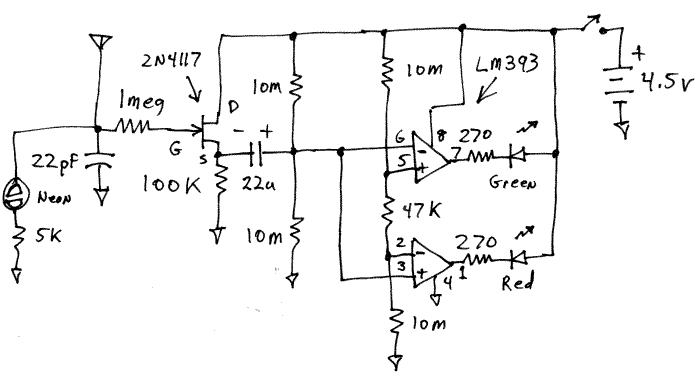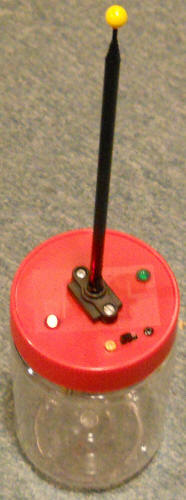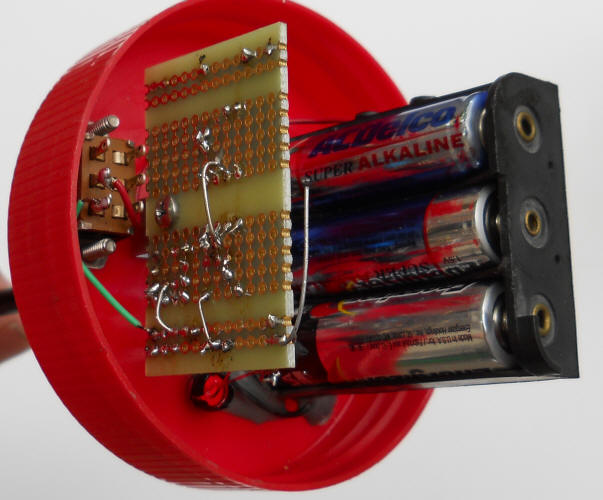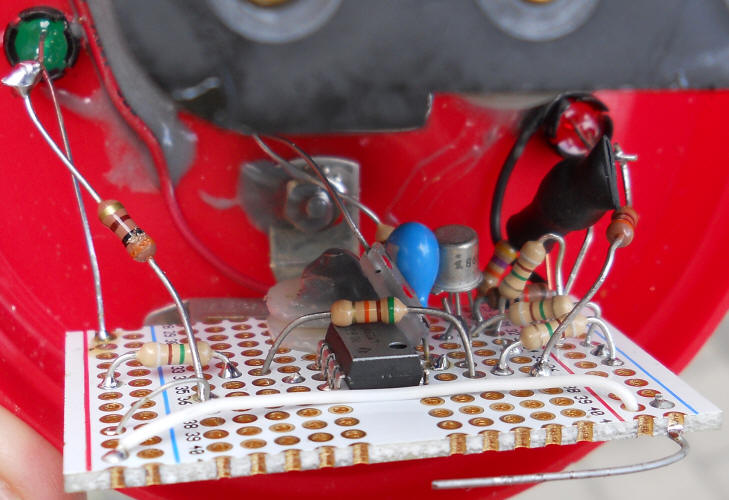

Yes, you read correctly, it's a ghost detector, assuming ghosts exist and, for some reason, have electric charge. Ok, this is a changing charge detector. If a ghost disturbs the electric field in the vicinity of this gadget you will see the results on the LEDs. Don't hold your breath, unless you wish to become a ghost yourself. There's a pair 'a normal LEDs that display whether the charge at the antenna is changing in a positive or negative direction (green vs red).

Here's how it works: The electrometer JFET buffers the voltage on the telescoping antenna. Its gate is gently biased low by a neon lamp that contains a little thorium that makes it slightly conductive (most, if not all, neons have thorium inside to help them start). The 22 pF is optional and reduces the 60 Hz "hum" level a bit. Much bigger and the response to sudden changes starts to be impaired. The 1 megohm in the gate is there to protect the JFET from static discharge when the antenna is touched to something. The FET configuration is called a "voltage follower" and the source of the JFET follows the gate fairly closely with a positive offset of a volt or two. That voltage is coupled through the 22 uF and biased up to 2.25 volts by two 10 megohm resistors. That voltage is applied to two comparators, to the positive input of one and the negative input of the other. The other inputs of the comparators are biased to have a slight offset produced by to the 47k resistor. The 47k resistor determines the width of the detection "window." The voltage from the capacitor must exceed the additional voltage produced by the 47k to light either LED. Most homes are literally awash in 60 Hz "hum" from the wiring and both LEDs will light since the voltage easily exceeds the window "width." Increasing the 47k can prevent that behavior but also decrease the sensitivity. In my chicken wire enclosed garden (basically a Faraday shield) only the green LED glows, probably due to slight offsets. In the garden I can pull the antenna all the way out and I can detect my pocket comb dragged through my hair (to charge it) from several yards away. Wiggling it back and forth causes each LED to light brightly. It's pretty sensitive! In the house both LEDs glow but I can still detect a charged comb for quite a distance by observing variations in the brightness of the LEDs.
One point: to give the circuit good low frequency response the 22 uF is quite large. As a result the unit takes a couple of minutes to stabilize after power is applied. The red LED will come on for a minute or two. The capacitor should be a tantalum type or a very low leakage aluminum. It would be fine to use a 1 uF (or more) non-polar ceramic capacitor or a film capacitor, too, in order to achieve the needed low leakage.
I built my Ghost Detector into a peanut butter jar:


This was a rushed project and I made a few classic mistakes. The big one: I should have faced the battery pack outward to make it easy to change the batteries! Duh.
You will notice I didn't use the exact values in the schematic but they're close. I took these from my 2% drawer so they're a little "odd." That 51k is the 47k in the schematic . I used 9.1 megohms for the 10 meghoms and 300 ohms for the 270 ohms in the schematic. Ignore these variations; they're insignificant. Notice that I covered the neon lamp with heat shrink tubing to keep out the light. Use heat shrink for this since the adhesive on black tape might be too conductive.
